Agua Caliente Band of Cahuilla Indians
5401 Dinah Shore Drive
Palm Springs, CA 92262
http://www.aguacaliente.org
Me Yah Whae: “Hello!”
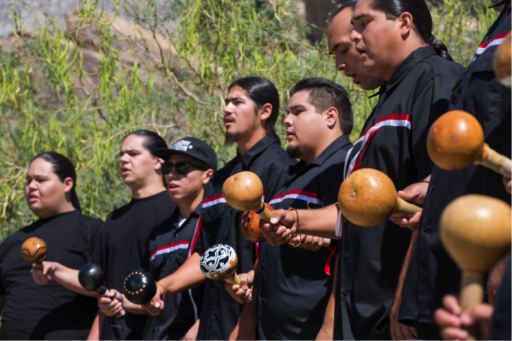
Agua Caliente bird singers. Photo courtesy Agua Caliente Band of Cahuilla Indians/Jaime Kowal
Since time immemorial, the Palm Springs area has been home to the Agua Caliente Band of Cahuilla Indians. Archaeological research has discovered that the Cahuilla have occupied Tahquitz Canyon for at least 5,000 years, mirroring the migration stories of the Cahuilla people.
The Cahuilla Indian name for the Palm Springs area was Sec-he (boiling water); the Spanish who arrived named it Agua Caliente (hot water). And then came the name “Palm Springs” in reference to both the native Washingtonia filifera palm tree and the Agua Caliente Hot Mineral Spring. The Hot Spring waters provided the Cahuilla with clean water, a place for bathing, and a connection point with a spiritual underworld populated by nukatem, or ancient sacred beings. The hot spring waters were also utilized for healing purposes. The ceremonial life of the Cahuilla was a rich one. Elaborate ceremonies marked every important milestone in life. Today, remnants of the traditional Cahuilla society exist such as rock art, house-pits and foundations, irrigation ditches, dams, reservoirs, trails, and food preparation areas, which still exist in the canyons.
Crops in the Agua Caliente area were irrigated by water from nearby streams. Remnants of these rock-lined irrigation ditches from Tahquitz, Andreas, and Chino Creeks are still visible in areas untouched by development. Archival documentation from the mid-1880s tells of elderly Indians memories of parents working on these ditches when they were very young.
Women of the band were responsible for gathering all of the plants that were used for food. Some of the basic food plants were acorns, mesquite beans, seeds of all kinds, wild fruit, agave and yucca. In addition, the Cahuilla had an extensive trade system with neighboring tribes. Food, shells, animal and mineral products were traded with the tribes of the surrounding areas.
– “Cultural History, Agua Caliente Band of Cahuilla Indians.
http://www.aguacaliente.org/content/History%20and%20Culture/
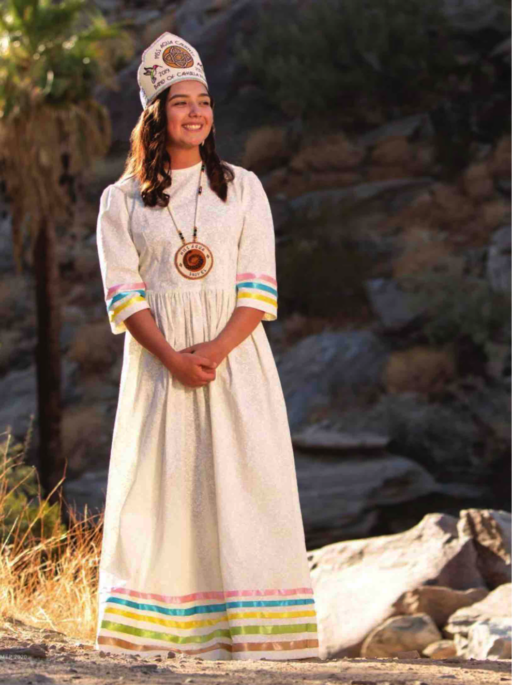
Miss Agua Caliente 2019, Destiny Saubel, a role model to other young people. Photo Courtesy Agua Caliente Band of Cahuilla Indians/Ethan Kaminsky
Agua Caliente cultural geography
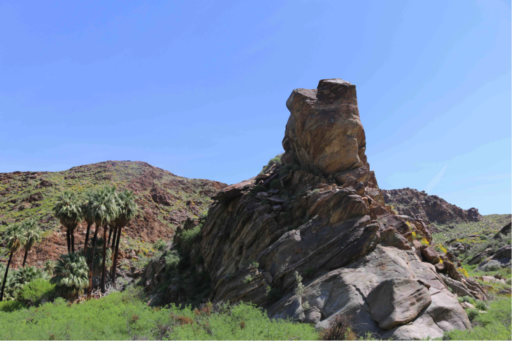
Rock in Palm Canyon. Photo Courtesy Agua Caliente Band of Cahuilla Indians/Kate Anderson
VIDEOS:
Indian Canyons: https://www.youtube.com/watch?v=SBtuYBfUmRs
Geology of the Canyon: https://www.youtube.com/watch?v=B_9LXIn9Q5I
Canyons & Water: https://www.youtube.com/watch?v=AuiE6kb2ygs
Hot Mineral Spring: https://www.youtube.com/watch?v=xKeRdi5–Sc
Hot Mineral Spring: https://www.youtube.com/watch?v=IUDtnQrMKK8
“The Original Social Network” by Kate Anderson
me-yah-whae Spring/Summer 2018
Trade was more than an exchange of gourd rattles and glass beads to the Agua Caliente – it was a cultural enterprise.
http://flipbook.pub/me-yah-whae/2018-spring-summer/?page=18
“A Hike Through Time” by Steven Biller
me-yah-whae Spring/Summer 2020
A ranger-led trek in the Indian Canyons reveals the enduring culture of the Agua Caliente people.
http://flipbook.pub/me-yah-whae/2020-spring-summer/?page=84
“Natural Wonders of the Indian Canyons” by Marissa Willman
me-yah-whae Fall/Winter 2016-17
Discover why the Agua Caliente Band of Cahuilla Indians makes it a priority to protect the Indian Canyons and the land’s precious desert ecosystem.
http://flipbook.pub/me-yah-whae/2016-fall-winter/?page=44
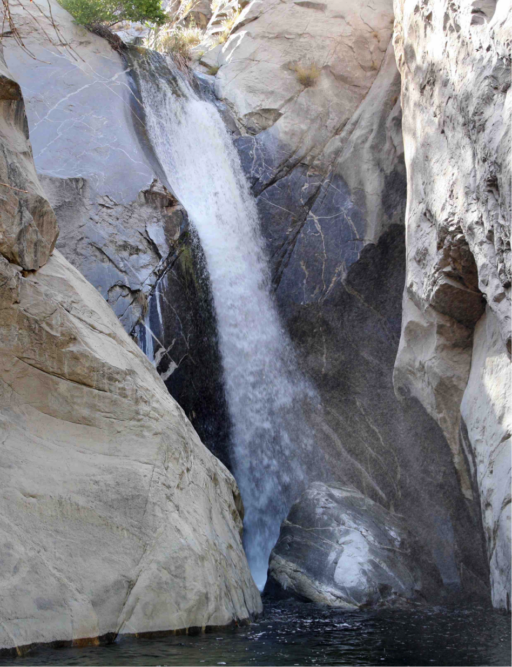
Tahquitz Falls. Photo Courtesy Agua Caliente Band of Cahuilla Indians
“Tahquitz 101” by Kate Anderson
me-yah-whae Spring/Summer 2017
To fully appreciate the beauty of Tahquitz Canyon and to understand the importance of this sacred place, one must start with the migration story of the first people who settled here.
http://flipbook.pub/me-yah-whae/2017-spring-summer/?page=74
“Tahquitz Canyon: Then and Now” by Marissa Willman
me-yah-whae Spring/Summer 2018
Exploring the ancient past of this beautiful desert sanctuary.
http://flipbook.pub/me-yah-whae/2018-spring-summer/?page=82
Water resources and the Agua Caliente tradition
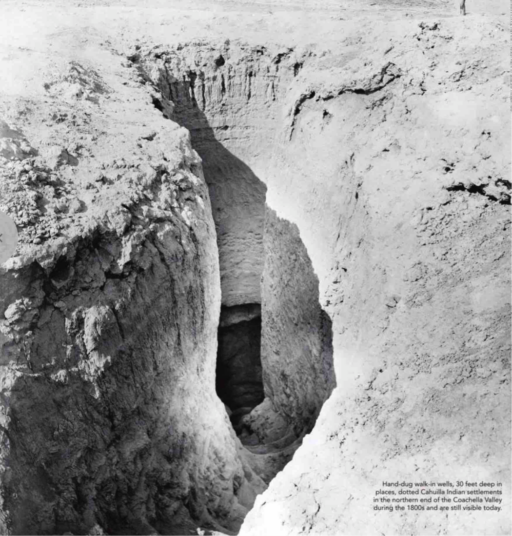
Hand-dug walk-in wells, 30 feet deep in places, dotted Cahuilla Indian settlements in the northern end of the Coachella Valley during the 1800s and are still visible today. Photo Courtesy Agua Caliente Band of Cahuilla Indians
VIDEO: Cultural Plaza Groundbreaking: https://www.youtube.com/watch?v=isXIvyx8YLY
“An Everlasting Bond” by Mona M. de Crinis
me-yah-whae Spring/Summer 2015
The Tribe’s long connection to the Coachella Valley aquifer transcends simple water usage.
http://flipbook.pub/me-yah-whae/spring-2015/?page=24
“A Flowing History”
me-yah-whae Fall/Winter 2018-19
An irrigation ditch in Tahquitz Canyon shows the ingenuity and adaptability of the Tribe’s forefathers.
http://flipbook.pub/me-yah-whae/2018-fall-winter/?page=36
“Sharing the Sacred Water” by Susan Myrland
me-yah-whae Spring/Summer 2020
Agua Caliente Cultural Plaza will connect past and present in a dynamic downtown Palm Springs experience.
http://flipbook.pub/me-yah-whae/2020-spring-summer/?page=50
“A Spring Awakening” by Mona M. de Crinis
me-yah-whae Spring/Summer 2019
Ancient waters and Tribal visionaries pump new life into downtown Palm Springs.
http://flipbook.pub/me-yah-whae/2019-spring-summer/?page=30
California’s native palm tree in Cahuilla culture
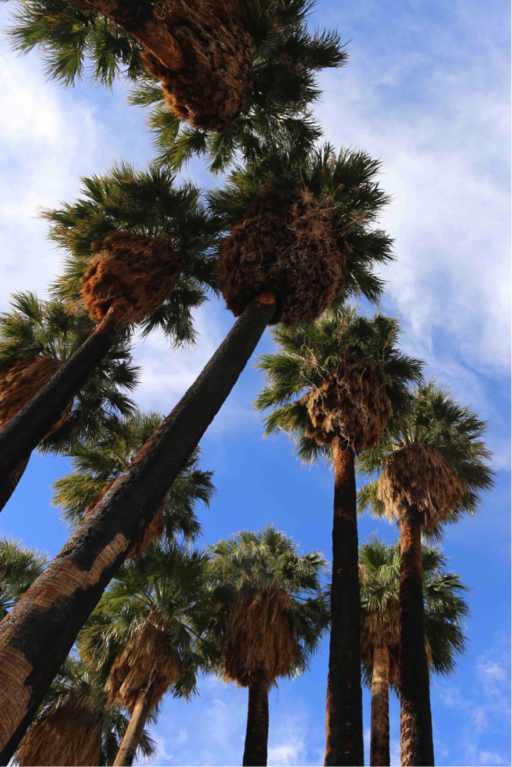
Washingtonia filifera palm trees. Photo Courtesy Agua Caliente Band of Cahuilla Indians/Kate Anderson
“The Cahuilla and the Palm: A Harmonious Lineage” by Jamey Christoph
me-yah-whae Spring/Summer 2015
The Indian Canyons’ enormous Washingtonia filifera oases showcase the Tribe’s historic ties to this life-sustaining tree.
http://flipbook.pub/me-yah-whae/spring-2015/?page=72
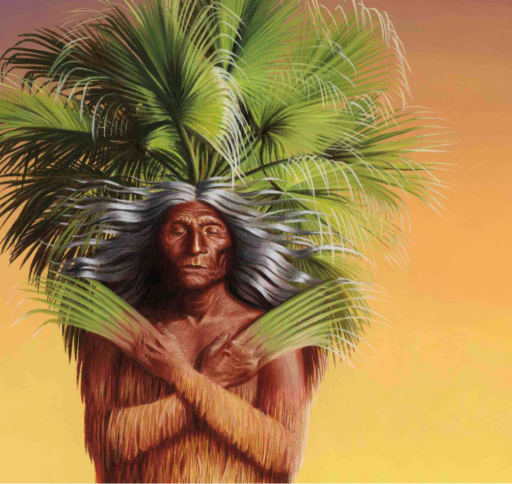
Stuart Funk, “A Monument to Treasure (Moul)” (detail). Photo Courtesy Agua Caliente Band of Cahuilla Indians/James W. Cornett
“Moul: The Man, The Tree, The Legend” by Kate Anderson
me-yah-whae Spring/Summer 2017
Wanting to leave behind something to benefit his people, the leader of the Sungrey tribe announced he was going to be a palm tree and stated that his name would be Moul.
http://flipbook.pub/me-yah-whae/2017-spring-summer/?page=46
Animals in the Cahuilla culture and environment
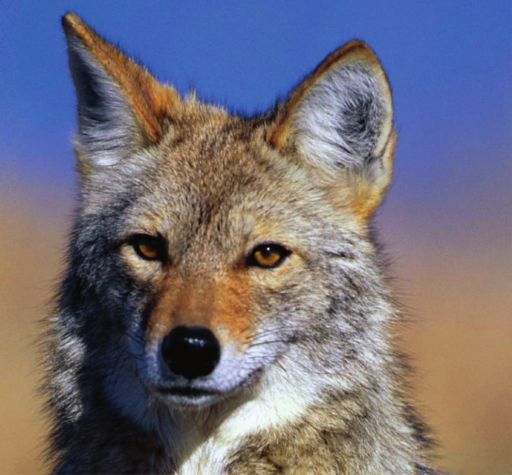
Coyote. Photo Courtesy Agua Caliente Band of Cahuilla Indians
“Nobility of the Fox”
me-yah-whae Spring/Summer 2015
The regal fox plays an important role in the culture of the Cahuilla people.
http://flipbook.pub/me-yah-whae/spring-2015/?page=112
“Coyote: Friend and Shaman”
me-yah-whae Spring/Summer 2016
Isil, coyote, was one of the first spiritual beings created by Temayawit at the dawn of time.
http://flipbook.pub/me-yah-whae/2016-spring-summer/?page=112
“Tuktum: The Sacred Wildcat”
me-yah-whae Spring/Summer 2017
According to Cahuilla legend, Tuktum (Wildcat) and Istam (Coyote) were two of the first spiritual beings created at the dawn of time.
http://flipbook.pub/me-yah-whae/2017-spring-summer/?page=112
“Along Came a Lizard … ” by Mona M. de Crinis
meh-yah-whae Fall/Winter 2017-18
The fringe-toed lizard is one of several species that face possible endangerment due to increased development of the desert valley floor.
http://flipbook.pub/me-yah-whae/2017-fall-winter/?page=36
“Bringing Back the Bighorn” by Ashley Breeding
me-yah-whae Spring/Summer 2019
The Agua Caliente Band of Cahuilla Indians is focused on protecting one of Coachella Valley’s most elusive yet mesmerizing inhabitants.
http://flipbook.pub/me-yah-whae/2019-spring-summer/?page=46
Bird Singing: a living tradition
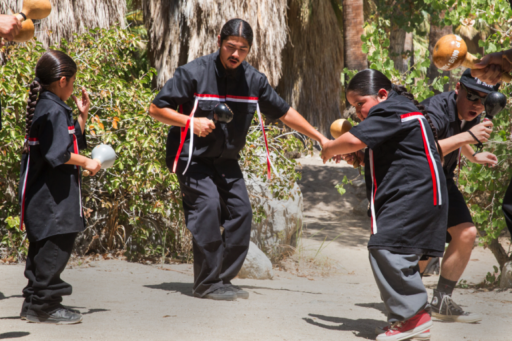
Bird singers dancing. Photo Courtesy Agua Caliente Band of Cahuilla Indians/Jaime Cowal
VIDEOS:
Bird Singers: https://www.youtube.com/watch?v=-C9jbug12XE
Migration Story: https://www.youtube.com/watch?v=q0GtEpJrvsM
“Dances With Birds” by Miranda Caudell
me-yah-whae Spring/Summer 2018
Agua Caliente Tribal members share and celebrate the story of their ancestors through the beat of the rattle and rhythmic footsteps.
http://flipbook.pub/me-yah-whae/2018-spring-summer/?page=48
“The Songs of Our Life” by Mona M. de Crinis
me-yah-whae Fall/Winter 2015-16
Through their time-honored ritual of bird singing, Tribal members share the story and spirit of the Agua Caliente Band of Cahuilla Indians.
http://flipbook.pub/me-yah-whae/2015-fall-winter/?page=34
“Artistry of a Gourd Rattle”
me-yah-whae Fall/Winter 2018-19
The makings of an ancient instrument.
http://flipbook.pub/me-yah-whae/2018-fall-winter/?page=54
“From Seed to Sound”
me-yah-whae Fall/Winter 2018-19
The seeds of Washingtonia filifera, the only palm native to California, are placed inside a hollowed gourd to make a rattle.
http://flipbook.pub/me-yah-whae/2018-fall-winter/?page=10
The kish: a traditional Cahuilla home
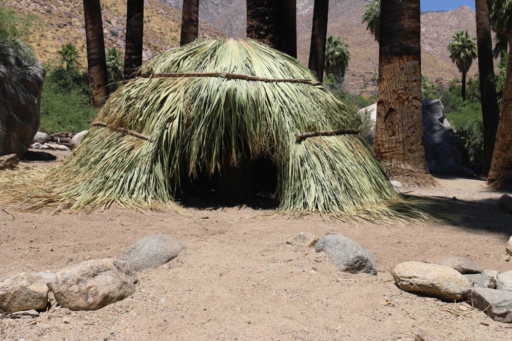
A kish, the traditional Cahuilla home. Photo Courtesy Agua Caliente Band of Cahuilla Indians/Kate Anderson
“Home Sweet Home”
me-yah-whae Fall/Winter 2019-20
Historically, Agua Caliente people lived in a kish, a small dome-shaped dwelling.
http://flipbook.pub/me-yah-whae/2019-fall-winter/?page=10
“Constructing a Kish”
me-yah-whae Fall/Winter 2019-20
An illustrated look inside the traditional Cahuilla home.
http://flipbook.pub/me-yah-whae/2019-fall-winter/?page=16
Traditional crafts and cuisine
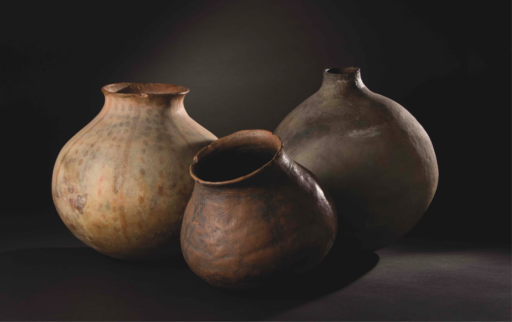
Cahuilla ollas Photo Courtesy Agua Caliente Band of Cahuilla Indians/Ethan Kaminsky
“Artful Artifacts”
me-yah-whae Fall/Winter 2015-16
Hundreds of years after Cahuilla ollas were lost in the landscape, artists and archaeologists are rediscovering their beauty and purpose.
http://flipbook.pub/me-yah-whae/2015-fall-winter/?page=16
“Nature Made”
me-yah-whae Spring/Summer 2020
Ancient bedrock mortar sites offer a glimpse into the culinary past of the Agua Caliente.
http://flipbook.pub/me-yah-whae/2020-spring-summer/?page=28
“The Cahuilla Kitchen” by Pamela Bieri
me-yah-whae Fall/Winter 2016-17
From sweet mesquite beans and palm fruit to savory meat, the food of the ancient Cahuilla is as varied and rich as the land they called home.
http://flipbook.pub/me-yah-whae/2016-fall-winter/?page=14
The Art of Cahuilla Basketry
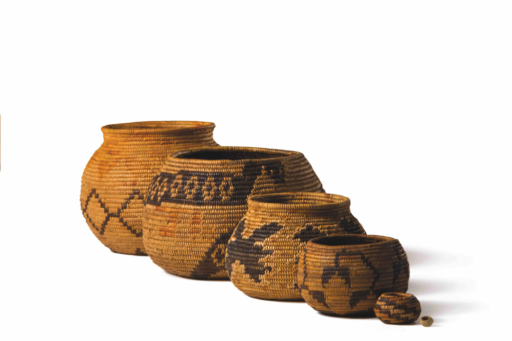
Traditional Cahuilla baskets Photo Courtesy Agua Caliente Band of Cahuilla Indians/Ethan Kaminsky
“Cahuilla Basketry: A Weaving of Culture and Beauty”
me-yah-whae Spring/Summer 2016
The Cahuilla people wove intimate relationships with the baskets that infused their daily lives.
http://flipbook.pub/me-yah-whae/2016-spring-summer/?page=30
“Master Weaver”
me-yah-whae Summer/Fall 2014
A postcard, circa 1920s, shows master weaver Dolores Patencio creating a coiled juncus basket.
http://flipbook.pub/me-yah-whae/2014-summer-fall/?page=104
Cultural preservation
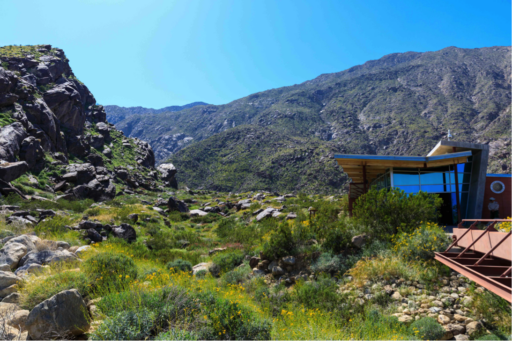
Tahquitz Visitor Center. Photo Courtesy Agua Caliente Band of Cahuilla Indians/Mark Davidson
VIDEO: The Agua Caliente school curriculum – https://www.youtube.com/watch?v=6CcYZB_ZOIY
“Keeping Cahuilla Alive” by Joan Page McKenna
me-yah-whae Spring/Summer 2019
Preserving this critically endangered language is vital to understand the Agua Caliente people’s identity, history, and culture.
http://flipbook.pub/me-yah-whae/2019-spring-summer/?page=16
“A Culture Worth Saving” by Kay Kudukis
me-yah-whae Fall/Winter 2017-18
A new generation steps up to preserve the past.
http://flipbook.pub/me-yah-whae/2017-fall-winter/?page=50
“Maintaining the Thread” by June Allan Corrigan
me-yah-whae Spring/Summer 2019
A new generation keeps the tradition of Agua Caliente basket weaving alive.
http://flipbook.pub/me-yah-whae/2019-spring-summer/?page=24
“Preserving the Past & Protecting the Present” by Mona M. de Crinis
me-yah-whae Spring/Summer 2017
The Agua Caliente Band of Cahuilla Indians takes steps to safeguard ancestral lands and the stories therein.
http://flipbook.pub/me-yah-whae/2017-spring-summer/?page=29
Tribal Leadership: Past, Present and Future
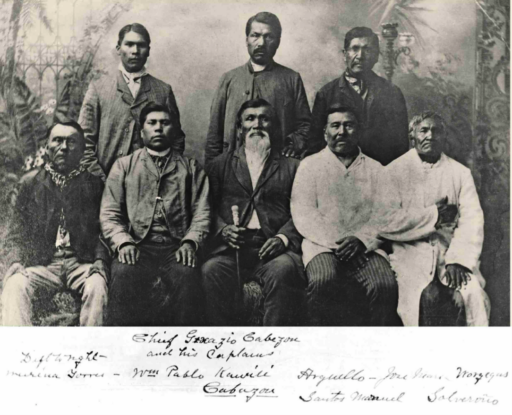
Chief Cabezon (front row, center) and his captains, circa 1891. Photo Courtesy Agua Caliente Band of Cahuilla Indians
“Enduring Leadership” (Overview)
http://flipbook.pub/me-yah-whae/spring-2015/?page=44
“Leading from Strength” (early-to-mid 1800s)
http://flipbook.pub/me-yah-whae/2015-fall-winter/?page=42
“Pushing Boundaries” (late 1800s)
http://flipbook.pub/me-yah-whae/2016-fall-winter/?page=56
“Born to Lead” (early 1900s)
http://flipbook.pub/me-yah-whae/2016-spring-summer/?page=40
“Spirited Leadership” (late 1800s-1930s)
http://flipbook.pub/me-yah-whae/2017-spring-summer/?page=52
“The Road to Citizenship” (1920s)
http://flipbook.pub/me-yah-whae/2017-fall-winter/?page=54
“The Arenas Case” (1940s)
http://flipbook.pub/me-yah-whae/2018-fall-winter/?page=58
“Leading Ladies” (1950s)
http://flipbook.pub/me-yah-whae/2019-spring-summer/?page=60
“The Self-Determined Sixties” (1960s)
http://flipbook.pub/me-yah-whae/2019-fall-winter/?page=60
“Determined to Succeed” (1970s)
http://flipbook.pub/me-yah-whae/2020-spring-summer/?page=58
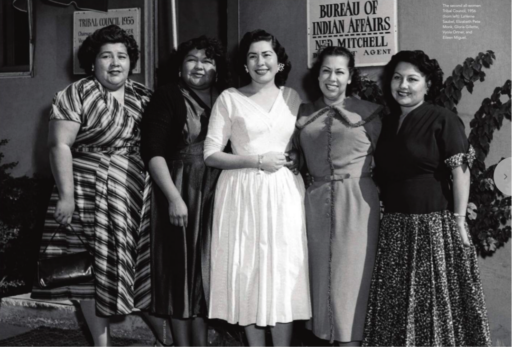
The second all-women Tribal Council, 1956. From left: LaVerne Saubel, Elizabeth Pete Monk, Gloria Gilette, Vyola Ortner, and Eileen Miguel. Photo Courtesy Agua Caliente Band of Cahuilla Indians
“The X Factor”
me-yah-whae Fall/Winter 2017-18
Q: What do you get when you put four women on the Tribal Council? A: Progress.
http://flipbook.pub/me-yah-whae/2017-fall-winter/?page=26
Veterans in the Agua Caliente community
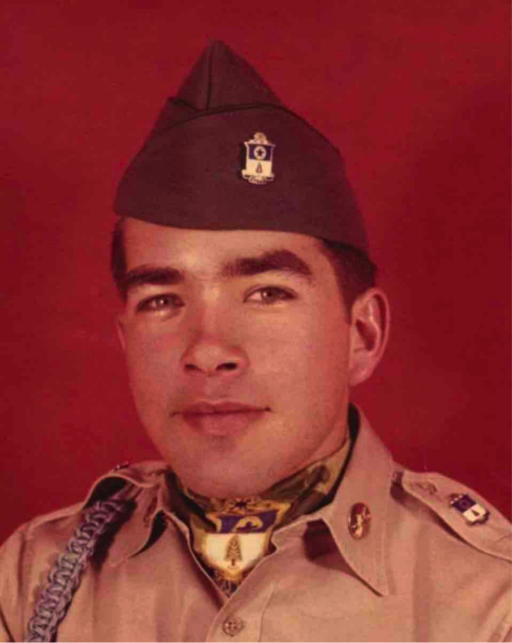
Richard M. Milanovich served as an Army ranger before serving on the Tribal Council and as Chairman. Photo Courtesy Agua Caliente Band of Cahuilla Indians
Portraits in leadership: Tribal members share their stories
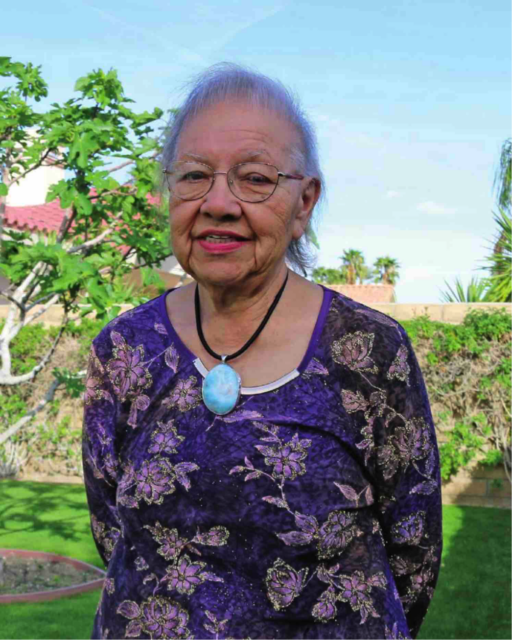
Tribal Elder Renona Pennington. Photo Courtesy Agua Caliente Band of Cahuilla Indians/Kate Anderson
Alana Segundo
http://flipbook.pub/me-yah-whae/2017-fall-winter/?page=20
Barbara Gonzales Lyons (former Chairman)
http://flipbook.pub/me-yah-whae/2019-spring-summer/?page=20
Beverly Patencio Diaz
http://flipbook.pub/me-yah-whae/2016-spring-summer/?page=18
Debbie Purnel
http://flipbook.pub/me-yah-whae/2019-fall-winter/?page=18
Esther Voorhees
http://flipbook.pub/me-yah-whae/spring-2015/?page=18
Frances Lucille Diaz Edwards Cummings (first female Tribal police officer)
http://flipbook.pub/me-yah-whae/2020-spring-summer/?page=18
Gloria Welmas Gillette
http://flipbook.pub/me-yah-whae/2015-fall-winter/?page=30
Leroy Segundo
http://flipbook.pub/me-yah-whae/2017-spring-summer/?page=20
Linda Gillette
http://flipbook.pub/me-yah-whae/2018-fall-winter/?page=16
Mildred “Millie” Brown
http://flipbook.pub/me-yah-whae/2018-spring-summer/?page=16
Renona Pennington
http://flipbook.pub/me-yah-whae/2016-fall-winter/?page=20
Vyola Ortner
http://flipbook.pub/me-yah-whae/2014-summer-fall/?page=22
Miss Agua Caliente
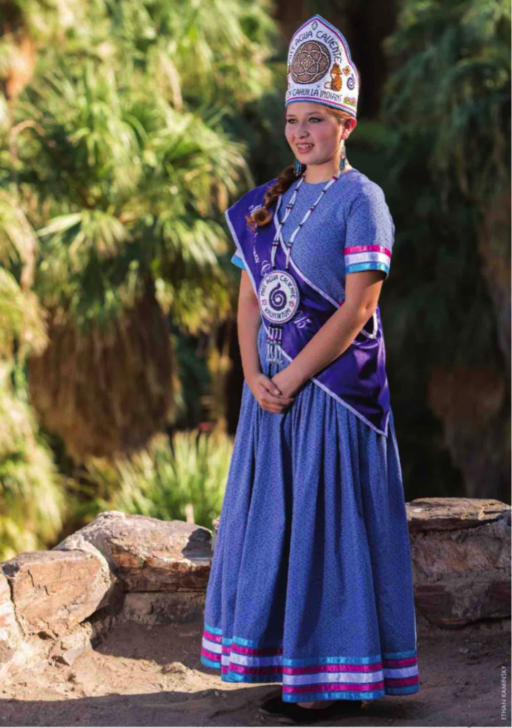
Miss Agua Caliente 2016, Trinity Dymonique (Dymond) Galindo. Photo Courtesy Agua Caliente Band of Cahuilla Indians/Ethan Kaminsky
The first Miss Agua Caliente was chosen in 2002 to represent the Tribe at the UNITY (United National Indian Tribal Youth) conference. Since then, a new Miss Agua Caliente has been chosen every year to represent the Tribe at local and national events. Each chooses her own gown colors and designs her crown.
VIDEOS:
Miss Agua 2014-2015: https://www.youtube.com/watch?v=T7bfFmZIirk
Miss Agua 2015-2016: https://www.youtube.com/watch?v=uL2hRkumxQ0
Miss Agua: 2016-2017: https://www.youtube.com/watch?v=S0MBiLhBJu8
Miss Agua 2017-2018: https://www.youtube.com/watch?v=yFjOF8XisQU
Miss Agua 2018-2019: https://www.youtube.com/watch?v=w6fx4RxnxJY
Miss Agua 2019-2020: https://www.youtube.com/watch?v=h1O-uZ3VBek
2015: Jacinda Townsend
http://flipbook.pub/me-yah-whae/spring-2015/?page=38
2016: Trinity Dymonique Galindo
http://flipbook.pub/me-yah-whae/2016-spring-summer/?page=20
2017: Jayla Grubbe
http://flipbook.pub/me-yah-whae/2017-spring-summer/?page=36
2018: Khayman Cunningham
http://flipbook.pub/me-yah-whae/2018-spring-summer/?page=22
2019: Justice Galindo
http://flipbook.pub/me-yah-whae/2019-spring-summer/?page=42
2020: Destiny Saubel
http://flipbook.pub/me-yah-whae/2020-spring-summer/?page=46

